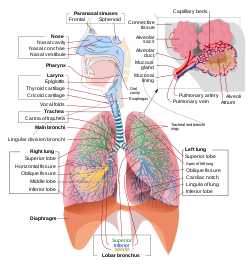**Respiratory System Anatomy and Gas Exchange**:
– Mammals have specific organs like lungs, alveoli, trachea, bronchi, and bronchioles for gas exchange.
– Birds use atria for gas exchange, while fish and aquatic animals rely on gills.
– The respiratory tract is divided into upper (nose, sinuses, pharynx) and lower (trachea, bronchi, alveoli) regions.
– Gas exchange occurs in alveoli, where air sacs with rich blood supply facilitate efficient exchange.
– Plants and animals have evolved unique respiratory systems based on size, environment, and evolutionary history.
**Ventilatory Volumes and Breathing Mechanics**:
– Lung volumes like tidal volume, residual volume, and total lung capacity are measured by spirometry.
– Minute ventilation, alveolar ventilation, and dead space ventilation are key respiratory volume measurements.
– Breathing involves rib movements like pump handle and bucket handle actions during inhalation and exhalation.
– The diaphragm and intercostal muscles play crucial roles in expanding the chest cavity for inhalation and exhalation.
– Real-time MRI shows the chest movements during breathing cycles.
**Gas Composition and Exchange Processes**:
– Alveolar air composition remains relatively constant during breathing cycles.
– Tidal volume, alveolar air volume, and dead space ventilation impact the amount of fresh air reaching alveoli.
– Gas exchange occurs in alveoli and pulmonary capillaries through a thin blood-air barrier.
– Oxygen and carbon dioxide partial pressures are equilibrated in alveolar air and blood.
– The Valsalva maneuver involves forceful exhalation against a closed glottis for specific purposes.
**Breathing Actions and Control of Ventilation**:
– Breathing can be influenced by coughing, sneezing, speech, and other actions.
– Respiratory muscles play a crucial role in voluntary acts and reflexes like the Valsalva maneuver.
– Ventilation is controlled by respiratory centers in the brainstem based on blood gas partial pressures.
– Neural pathways receive information on arterial blood gas levels to regulate breathing rate and depth.
– Responses to low atmospheric pressures involve adjustments in alveolar air pressure during inhalation and exhalation.
**Respiratory System Function and Blood Gas Regulation**:
– The primary function of the respiratory system is to maintain optimal partial pressures of respiratory gases in alveolar air and blood.
– Lung anatomy and airway structure contribute to efficient gas exchange and monitoring mechanisms regulate breathing based on blood gas tensions.
– Homeostasis disruptions can lead to respiratory acidosis or alkalosis, with renal adjustments compensating in the long term.
– Oxygen is carried in blood bound to hemoglobin, while carbon dioxide is mainly carried as bicarbonate ions.
– Breathing rate and depth are primarily controlled by blood CO2 levels, with aortic and carotid bodies sensitive to arterial oxygen levels.
The respiratory system (also respiratory apparatus, ventilatory system) is a biological system consisting of specific organs and structures used for gas exchange in animals and plants. The anatomy and physiology that make this happen varies greatly, depending on the size of the organism, the environment in which it lives and its evolutionary history. In land animals, the respiratory surface is internalized as linings of the lungs. Gas exchange in the lungs occurs in millions of small air sacs; in mammals and reptiles, these are called alveoli, and in birds, they are known as atria. These microscopic air sacs have a very rich blood supply, thus bringing the air into close contact with the blood. These air sacs communicate with the external environment via a system of airways, or hollow tubes, of which the largest is the trachea, which branches in the middle of the chest into the two main bronchi. These enter the lungs where they branch into progressively narrower secondary and tertiary bronchi that branch into numerous smaller tubes, the bronchioles. In birds, the bronchioles are termed parabronchi. It is the bronchioles, or parabronchi that generally open into the microscopic alveoli in mammals and atria in birds. Air has to be pumped from the environment into the alveoli or atria by the process of breathing which involves the muscles of respiration.
| Respiratory system | |
|---|---|
 A complete, schematic view of the human respiratory system with their parts and functions. | |
| Details | |
| Identifiers | |
| Latin | systema respiratorium |
| MeSH | D012137 |
| TA98 | A06.0.00.000 |
| TA2 | 3133 |
| FMA | 7158 |
| Anatomical terminology | |
In most fish, and a number of other aquatic animals (both vertebrates and invertebrates), the respiratory system consists of gills, which are either partially or completely external organs, bathed in the watery environment. This water flows over the gills by a variety of active or passive means. Gas exchange takes place in the gills which consist of thin or very flat filaments and lammellae which expose a very large surface area of highly vascularized tissue to the water.
Other animals, such as insects, have respiratory systems with very simple anatomical features, and in amphibians, even the skin plays a vital role in gas exchange. Plants also have respiratory systems but the directionality of gas exchange can be opposite to that in animals. The respiratory system in plants includes anatomical features such as stomata, that are found in various parts of the plant.
